|
Fifty years ago, the AR-10 rifle design
of Eugene Stoner seemed to be a commercial failure, with
limited sales overseas, and almost none in the USA. The AR-10
was an excellent design, but was way ahead of its time, losing
out on the US Military contract to the rifle that would become
the M-14. The AR-10 was later scaled down to accommodate a new
.22 caliber center fire military cartridge, and was designated
the M-16.
Over the past dozen years or so, the old AR-10
design has been resurrected, and has now become very popular
with civilians, and has also had some success with the US
Military for special units, providing more power and greater
range than the M-16, and it especially outperforms the current
short-barreled M-4 carbines. The problem with many current
AR-10s is that they are just too heavy for anything but a bench
gun. Thankfully, some manufacturers are building lighter
versions of the AR-10, such as the ones reviewed here from DPMS
Panther Arms.
We recently received two new versions of their
LR-308 and also one of their LR-300 magnum rifles here at the
palatial offices of Gunblast.com for review. The one that
interests me the most is their AP-4 Carbine. It is a .308 (7.62
NATO) chambered weapon with a relatively light sixteen inch
barrel, that has an M-4 style profile. The AP-4 has a three inch
flash suppressor, the design of which would make a pretty good
weapon in its own right. Poking that thing into someone would
leave a nasty wound. The AP-4 also wears a bayonet lug, and has
a handy six-position telescoping buttstock. It uses twenty-round
metal magazines, which functioned flawlessly during our tests.
The AP-4 has a removable A2 style adjustable rear sight that
attaches to the flattop upper receiver, which has an integral
full-length Picatinny rail for the easy and secure mounting of
scopes or other optical sights. The front sight is the standard
A2 type, and is not removable. The AP-4 is equipped with
sling swivels front and rear, and comes supplied with a nylon
web sling and two twenty-round magazines. Unlike previous DPMS
AR-10 style weapons, the AP-4 has a forward assist and empty
case deflector machined into the upper receiver. It also has a
dust cover over the ejection port. The hand guard on the AP-4 is
of the tubular aluminum free-floated type, with lateral grooves
machined into its outer surface. The AP-4 weighs eight pounds
and eleven ounces with an empty magazine. The trigger pull on
the AP-4 measured six pounds and ten ounces, and is my only
complaint with the weapon. All of the controls are of the
typical AR style, and worked perfectly throughout the tests.
The other LR-308 sent is not a standard catalog
item, but was built to show off some of the options available on
the weapon. It wears a free-floated hand guard that has four
integral Picatinny rails set at ninety degrees apart for the
attachment of accessories such as laser sights, lights,
infrared, and other such devices to the hand guard. It also has
a smooth barrel profile, and has another piece of Picatinny rail
integral to the gas block, for a detachable front sight.
The third rifle sent to us is chambered for the
.300
Remington Short Action Ultra Mag cartridge (SAUM). The SAUM
rifle wears a twenty inch stainless fluted barrel with a
one-in-ten inch twist, and is especially useful for firing long,
heavy thirty caliber bullets at long range. The Remington
Match ammo tested fired a 190 grain bullet at 2741
feet-per-second (fps) from the twenty inch barrel, measured at
ten feet from the muzzle. This is a significant advantage over
the .308 Winchester (7.62 NATO) cartridge fired from the
AP-4, which launched a 168 grain bullet at 2475 fps from its
shorter tube. The disadvantage is that the .300 SAUM
carbine weighs almost two pounds more, and its magazine holds
only four cartridges instead of twenty. However, it does pack a
heavier punch, and has a flatter long-range trajectory.
The upper receiver of the SAUM is of the "slick side"
type, with no case deflector or forward assist. The only
malfunctions with the .300 SAUM rifle was that the bolt did not
lock open after the last shot. The latch was working properly,
but the ammo did not fully retract the bolt to activate the
latch. Perhaps another type of ammo would work just fine, but I
had only the one type available.
Accuracy of the weapons tested was very good.
The .300 SAUM grouped into one and one-eighth inches at 100
yards. It would usually put two out of three close together, and
throw the third out, opening the group up to just over one inch.
Most likely, the heavy trigger pull is to blame for this. A good
trigger job could lighten the pull, and make the weapon much
easier to shoot accurately. The trigger pull on the .300 SAUM
measured six pounds and eleven ounces. A better shooter
might be able to make better use of the stock trigger, but I
have been spoiled by using match triggers on most of my ARs. I
also believe that trying other loads in this carbine could
improve upon its accuracy.
The accuracy of the .308 AP-4 was outstanding,
despite the heavy trigger. As can be seen in the picture,
this little carbine produced groups measuring just three-eighths
of an inch at 100 yards using Federal Gold Medal match
ammo. I was impressed. That is fine accuracy from what is
essentially a battle carbine.
I also tried out a new recoil-absorbing rifle
rest from Hyskore while shooting these DPMS Panther
carbines. I believe that the rest will prove more useful with
bolt-action weapons. While it did a dandy job of soaking up
recoil, the long magazines could not be used with the Hyskore
rest, as they could with the Target
Shooting Model 1000 rest. I have a couple of .375
H&H Magnum rifles to test in a couple of weeks, and the
Hyskore should get a good workout with those.
I was very pleased with the DPMS Panther
carbines, especially the AP-4. We keep hearing reports of the
5.56mm cartridge failing to penetrate cinder block houses and
other obstacles in Iraq. The US Army and Marine Corps should
order a few hundred of these Panther .308 carbines and put them
to immediate use. They weigh just one and one-half pounds more
than the M-4, but pack a lot heavier punch. One on every rifle
squad should prove very useful. Also, for a person wanting a
good home defense rifle that can do double duty for deer
hunting, the Panther AP-4 should prove ideal.
Check them out online at: www.dpmsinc.com.
To order DPMS rifles online, go to www.lowpriceguns.com.
Jeff Quinn
  
Got something to say about this article? Want to agree (or
disagree) with it? Click the following link to go to the GUNBlast Feedback Page.
|
|
Click pictures for a larger version.
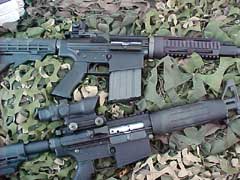
DPMS' LR-308 carbines in .308 (7.62 NATO). At bottom is
the standard-issue model, with the "tricked-out"
version above.
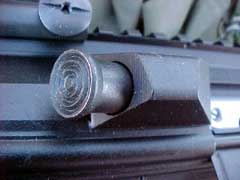
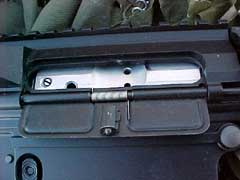
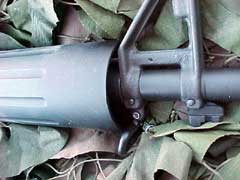
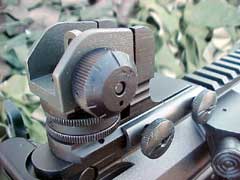
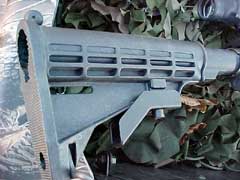
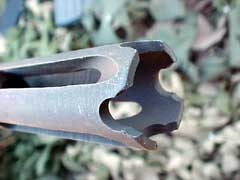
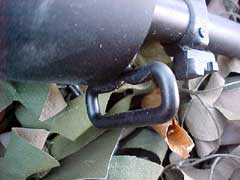
The standard LR-308 features include (top to bottom):
brass deflector and forward assist, dust cover, aluminum
tubular handguard & standard A2 front sight, removable
A2-style rear sight, six-position telescoping buttstock, flash
suppressor, and sling swivels.
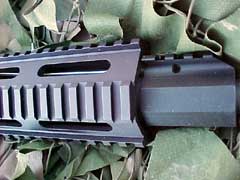
Optional handguard with four Picatinny rails and gas
block with rail.
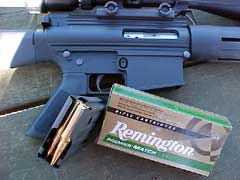
.300 Remington SAUM model.
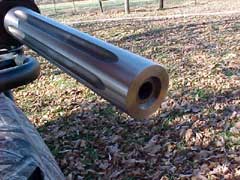
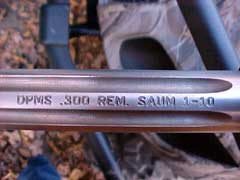
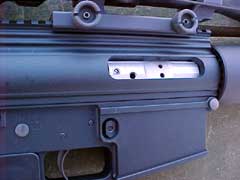
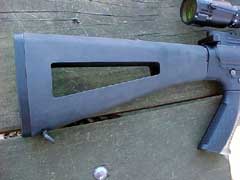
.300 Remington SAUM model features a heavy stainless
fluted barrel with a 1-10 twist, "slick side"
receiver, and unique skeletonized buttstock.
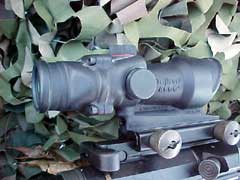
Trijicon ACOG
scope.
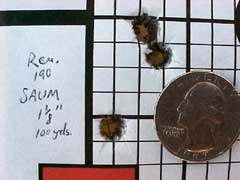
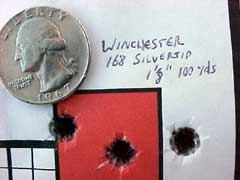
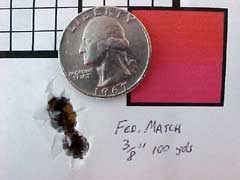
The DPMS AR-10s proved to be very accurate rifles.
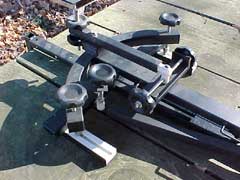
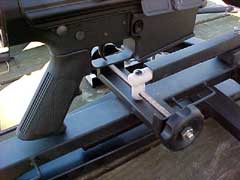
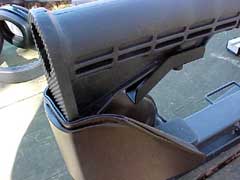
Hyskore's new recoil-absorbing rifle rest.
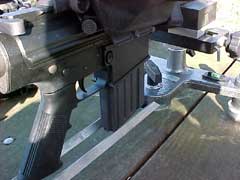
For AR-type rifles, author prefers the Target
Shooting Inc. Model 1000 rifle rest to all others.
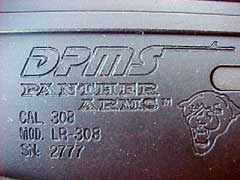
|
![]()